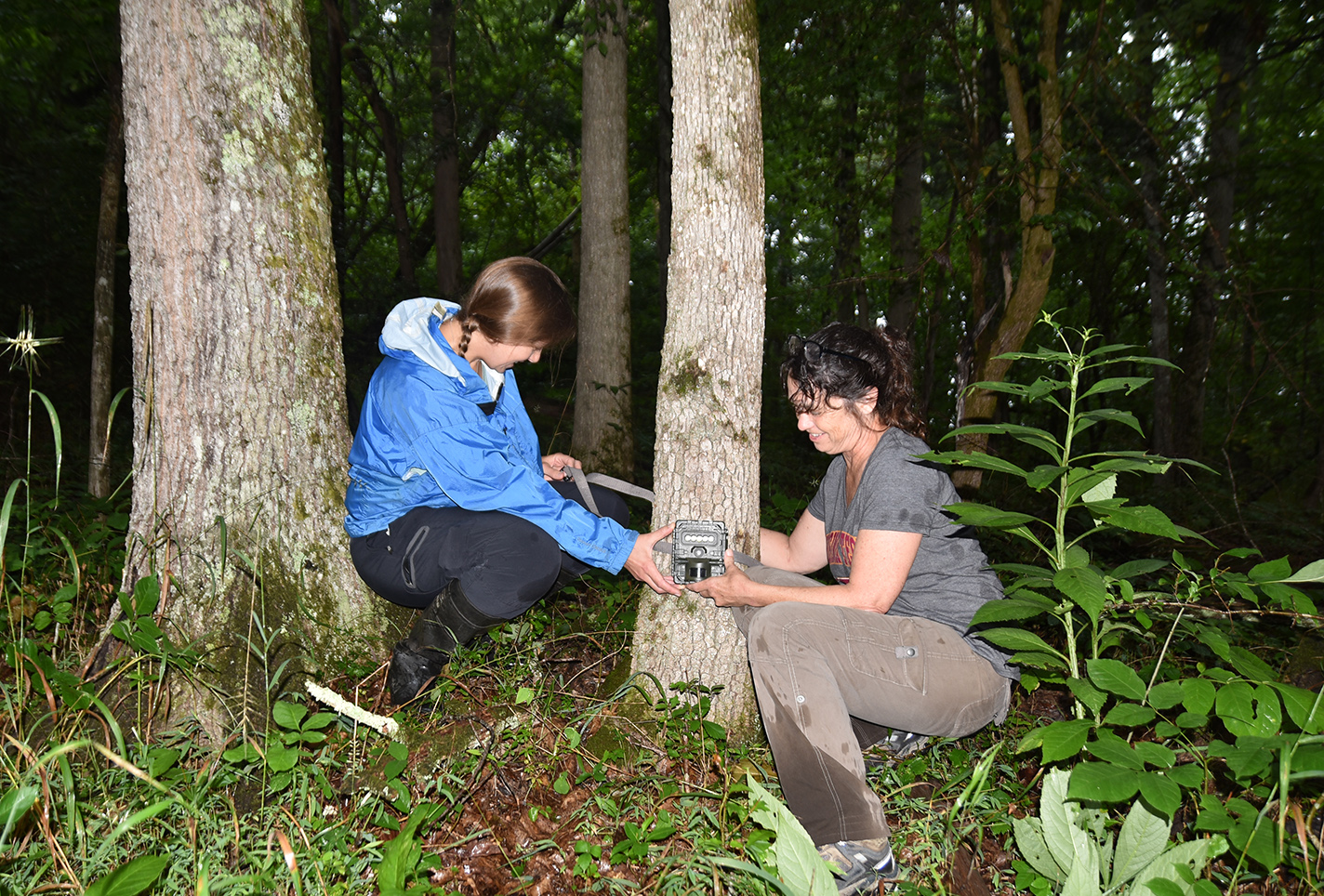
DWR Furbearer Biologist Leah Card (left) and Virginia Tech researcher Dr. Marcella Kelly setting up a trail camera on the author’s land.
Virginia Tech has initiated its Virginia Gray Fox Project (VGFP), led by Dr. Marcella Kelly and Ph.D. student Victoria Monette of the Department of Fisheries and Wildlife Conservation. Funded by the Virginia Department of Wildlife Resources (DWR), the project’s objective is to ascertain the status of the gray fox (Urocyon cinereoargenteus) that, anecdotally, appears to have decreased in the Old Dominion. To accomplish that goal, Tech researchers will be positioning trail cameras across the Commonwealth in a wide variety of public and private land habitats.
In 2024, researchers will focus on Virginia’s western counties and will have gained data on the entire state by the time the three-year project ends. Leah Card, furbearer project leader for DWR, gave an overview of the fox’s status and the study.
“Over the past 20 years, gray fox populations have been reported to be in decline in many states, including those in the Midwest and along the East Coast,” she said. “Sightings of gray fox in Virginia have also been in decline, with fewer observations reported by Virginia bow hunters over the past 20 years—a decrease of 66.1 percent.
“The number of gray fox pelts sold by trappers to Virginia fur dealers also declined 97.2 percent over this time. Despite this anecdotal evidence of decline, there haven’t been any published studies in Virginia on the gray fox population status, and little is known about the current distribution and status of them in the state. Given this lack of information, the VGFP is very important for us to have a better understanding of the population in Virginia.”
Card relates that a few potential reasons for the species’ regression have been suggested, including the loss of early successional habitat, increased urbanization, and increased competition with coyotes. Gray foxes don’t tend to do as well in urban areas, as compared to other mesocarnivores—such as the red fox and coyote—as studies suggest grays may require forest cover. In addition, coyotes may impact this canid either through direct predation or through competition over the same prey resources. Gray foxes, the biologist continued, may avoid areas used by coyotes for these reasons.
Monette says that some people do not know that the term “mesocarnivores” refers to small- to medium-sized carnivores that consume primarily meat, but also insects and vegetation make up 20-30 percent of their diet. Gray foxes have a relatively generalist diet, consuming primarily small mammals and birds and eggs, but will also eat frogs, insects, berries and fruits. Grays also require forest cover and can climb trees. There is only one other canid species in the world known to have the ability to climb.
“Something else that may be worth noting is that gray foxes are historically a native canid species to Virginia, while red foxes (another competitor) and coyotes are not historically native to the East Coast,” she said.
Wildlife disease has also been suggested as a contributing factor, as these creatures are susceptible to diseases and parasites such as canine distemper virus, parvovirus, heartworm, and, in rare instances, rabies.
Card admits that surveying an elusive creature such as the fox is a challenge, and that’s where state sportsmen and sportswomen as well as wildlife enthusiasts can contribute. “We can use the help of interested landowners to increase the number and spatial range of game cameras used for the project,” Card said. “We are inviting landowners who own camera traps/trail cameras (or who would like to purchase one) to set the cameras out on their lands to survey for gray foxes and other wildlife.
“For the 2025 and 2026 summer seasons, we also are interested in gaining access to private lands to set up project cameras. Victoria Monette has created a form for interested individuals and there is a set protocol for how the camera(s) should be set up, so that the data can be compared with the other cameras in the study. The cameras should be set along a wildlife trail, stream, road, or any existing pathway where wildlife including foxes are likely to travel.”
Even if gray foxes are not observed by the camera, continues Card, this is still useful data as it may suggest that they are not using the area. Other ways that the public can help is by being good wildlife stewards. Removing attractants such as human or pet food, securing trash, and protecting chicken coops or rabbit pens with proper fencing, can prevent conflicts with wildlife such as foxes and keep them from associating humans with food.
Lastly, the public can help collect data on wildlife and plants by taking photos, with location and date information, and sharing this information with other citizen science programs.
Summer 2024 the focus is on the Appalachian Mountain region (Appalachian Plateau, Valley and Ridge, and Blue Ridge combined); 2025 will be the Piedmont, and 2026 will be the Coastal Plain.
If you are interested in participating in the Virginia Gray Fox Project, submit a form.
Card emphasizes that other species also are of concern. “We rely on the public to gain sighting information on rare mammals in the state, including fishers, spotted skunks, porcupines, armadillos, and Alleghany woodrats,” she said. “If anyone observes these animals, either in-person or by capturing a photo with a camera trap, it would be great if they could report it. “Helpful information includes location data where the animal was observed, the date of the observation, and any photos or videos that were taken of the animal.”
Bruce Ingram for the Virginia Department of Wildlife Resources


